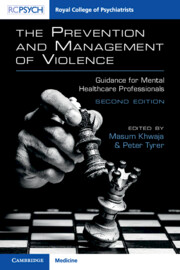Book contents
- The Prevention and Management of Violence
- The Prevention and Management of Violence
- Copyright page
- Dedication
- Contents
- Contributors
- Preface
- Abbreviations
- Section 1 General Aspects of Management
- Section 2 Medical and Psychological Intervention
- Introduction to Section 2
- Chapter 6 Use of Medication and Electroconvulsive Therapy in the Management of Violence
- Chapter 7 Psychological, Psychosocial and Psychotherapeutic Interventions for the Prevention and Management of Violence
- Chapter 8 Prevention and Management of Violence in Inpatient Psychiatric Settings
- Section 3 Violence in Different Settings
- Section 4 Management in Other Groups
- Section 5 Violence and Society
- Section 6 Engagement and Understanding
- Index
- References
Chapter 7 - Psychological, Psychosocial and Psychotherapeutic Interventions for the Prevention and Management of Violence
from Section 2 - Medical and Psychological Intervention
Published online by Cambridge University Press: 09 May 2023
- The Prevention and Management of Violence
- The Prevention and Management of Violence
- Copyright page
- Dedication
- Contents
- Contributors
- Preface
- Abbreviations
- Section 1 General Aspects of Management
- Section 2 Medical and Psychological Intervention
- Introduction to Section 2
- Chapter 6 Use of Medication and Electroconvulsive Therapy in the Management of Violence
- Chapter 7 Psychological, Psychosocial and Psychotherapeutic Interventions for the Prevention and Management of Violence
- Chapter 8 Prevention and Management of Violence in Inpatient Psychiatric Settings
- Section 3 Violence in Different Settings
- Section 4 Management in Other Groups
- Section 5 Violence and Society
- Section 6 Engagement and Understanding
- Index
- References
Summary
Written by a multidisciplinary team of experienced clinicians, this chapter provides the reader with an initial outline of some of the complex psychological mechanisms which underlie or can give rise to violence, such as trauma, problems with attachment and failure to develop a capacity to mentalise, as well as pointers for a wider review of the literature. This is followed by an overview of the range of current evidence-based psychological interventions and therapies available for the prevention and management of violence. Importantly, whilst their approach may differ, they all make use of the therapeutic relationship as an agent for change. The interventions include anger management, positive behavioural support, mentalisation-based techniques, application of a psychoanalytic perspective, family or systemic therapy, help with work experience, education and addressing substance misuse. This chapter will be of interest to professionals in a variety of settings who would like to find out more about how they can make sense of and try to prevent and reduce violence, as well as to patients, carers and the wider public.
Keywords
- Type
- Chapter
- Information
- The Prevention and Management of ViolenceGuidance for Mental Healthcare Professionals, pp. 107 - 117Publisher: Cambridge University PressPrint publication year: 2023



